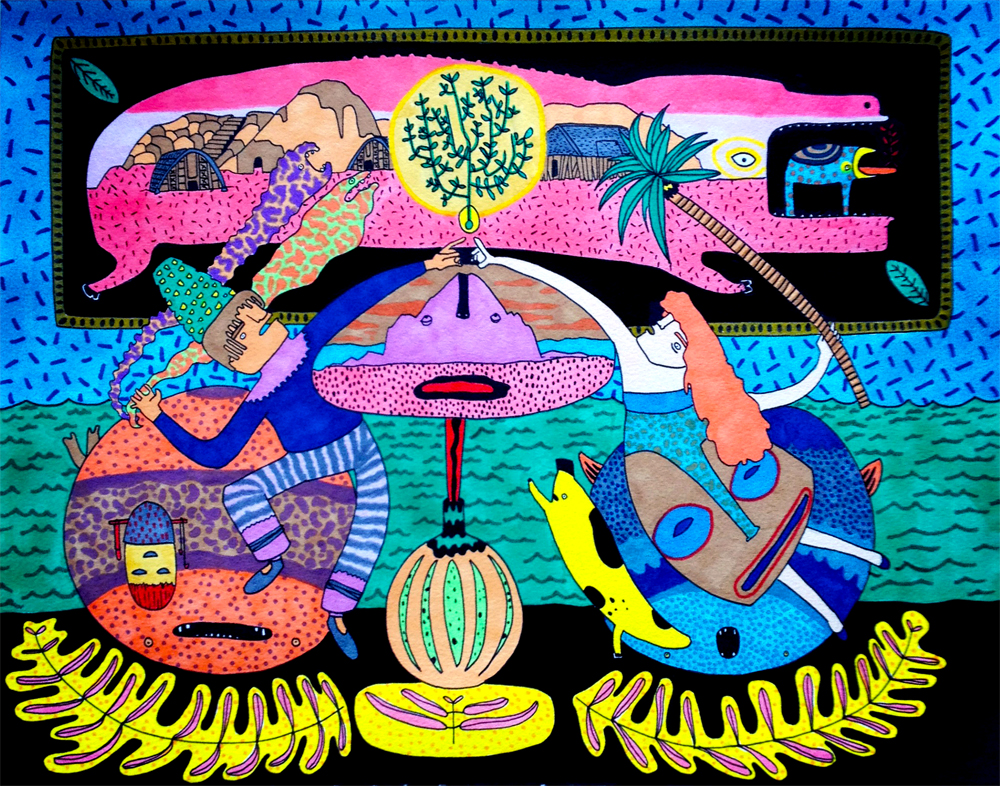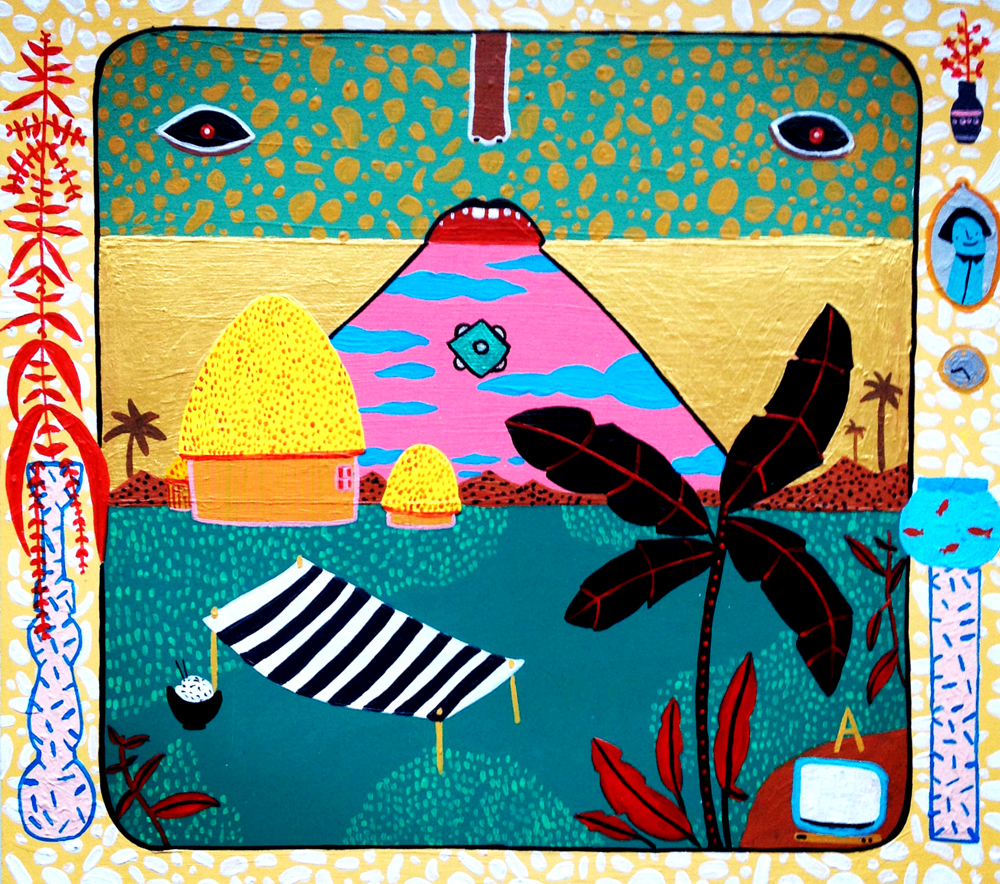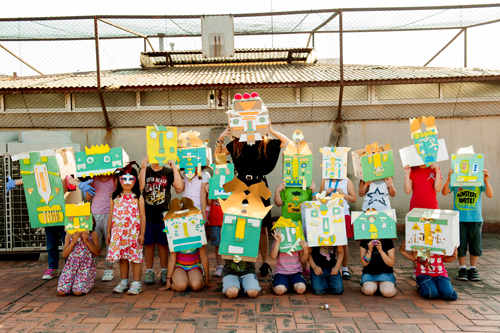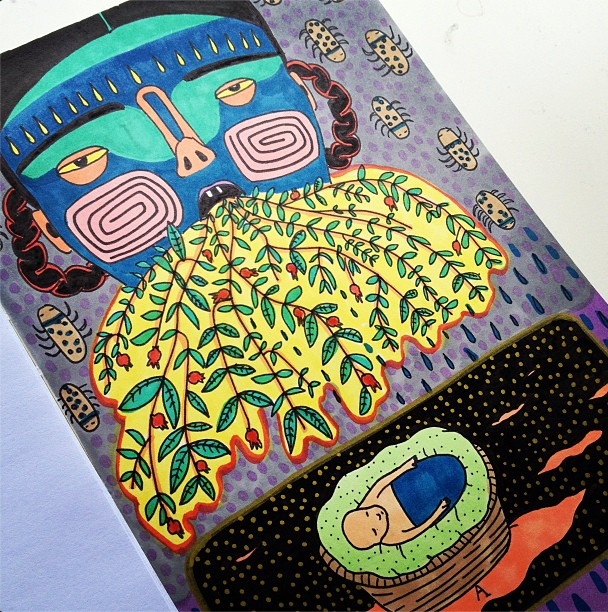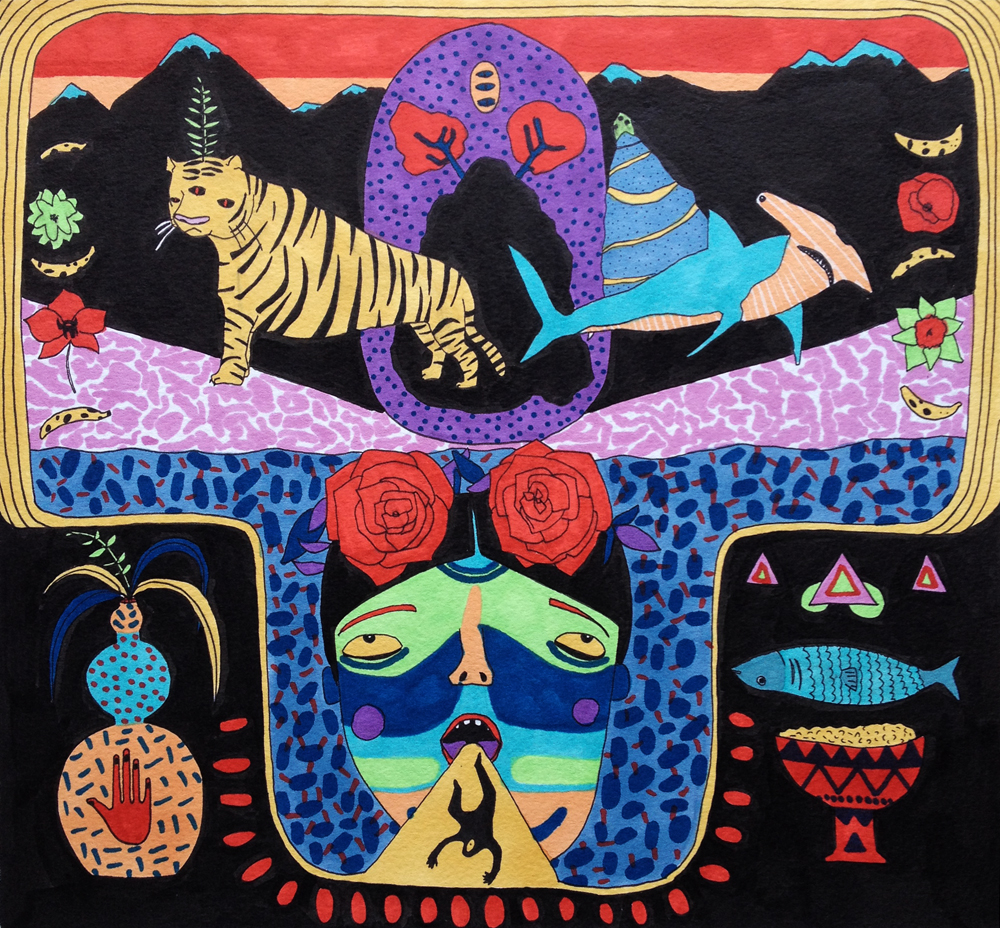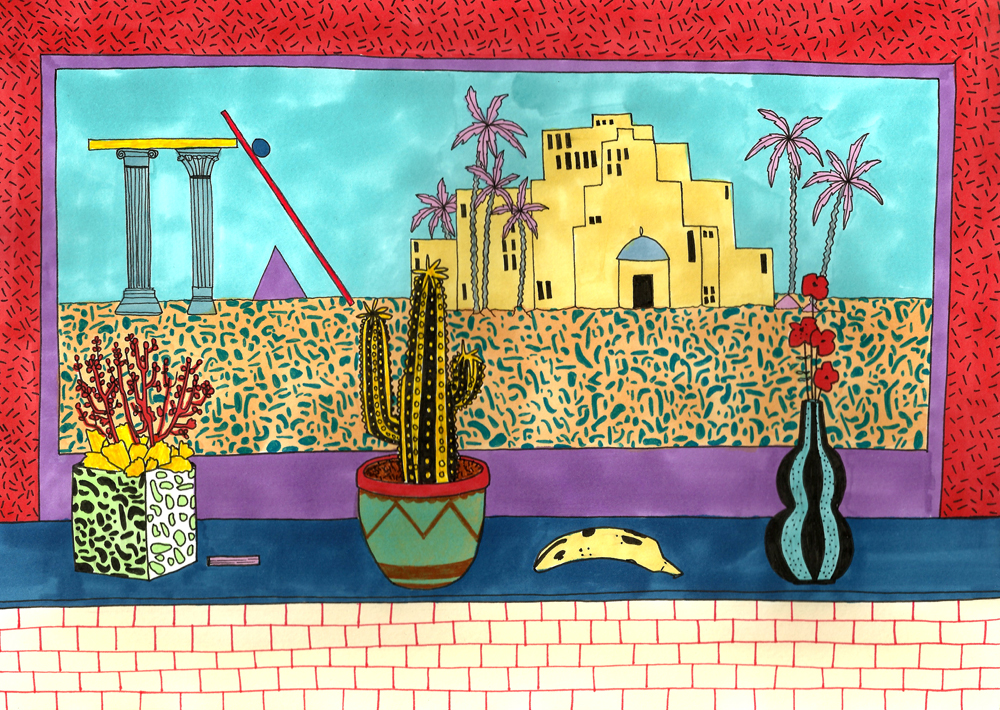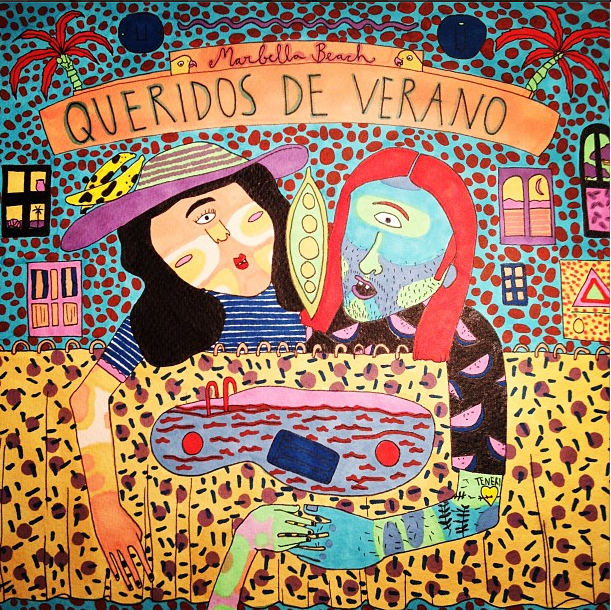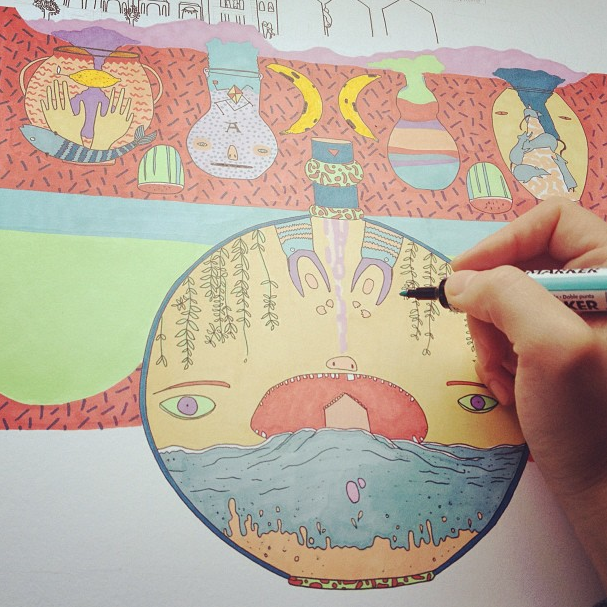It’s hard not to be intrigued by Cristina Martín and her artwork, especially after watching the short artistic “about me” video on her website. While honing and expanding her own repetoire, Martín has focused on helping young artists develop their own unique styles. In her world color, hard geometric lines, whimsy and tribal live together in harmony. Her work is fresh, intriguing, and fun.
As a Barcelona native recently transplanted to London, England, Martín often finds herself unintentionally incorporating representations of her Barcelona roots (like bright colors and a certain lightness) into her work. She is refreshingly uninhibited, a trait potentially derived from working as an art educator with young children for four years. This experience was profoundly inspirational and helped her discover “how magical the smaller stories are.”
Below you will find out all about Martín, her childhood, journey, direction, and purpose. If some phrases sound a bit foreign/funky, they are meant to be! Though very capable in English, she has some hiccups in complete translation. These were left “as-is” for they capture her meaning in a perfectly charming way! Enjoy.
Emily Frankoski: Where are you from originally and where do you now reside?
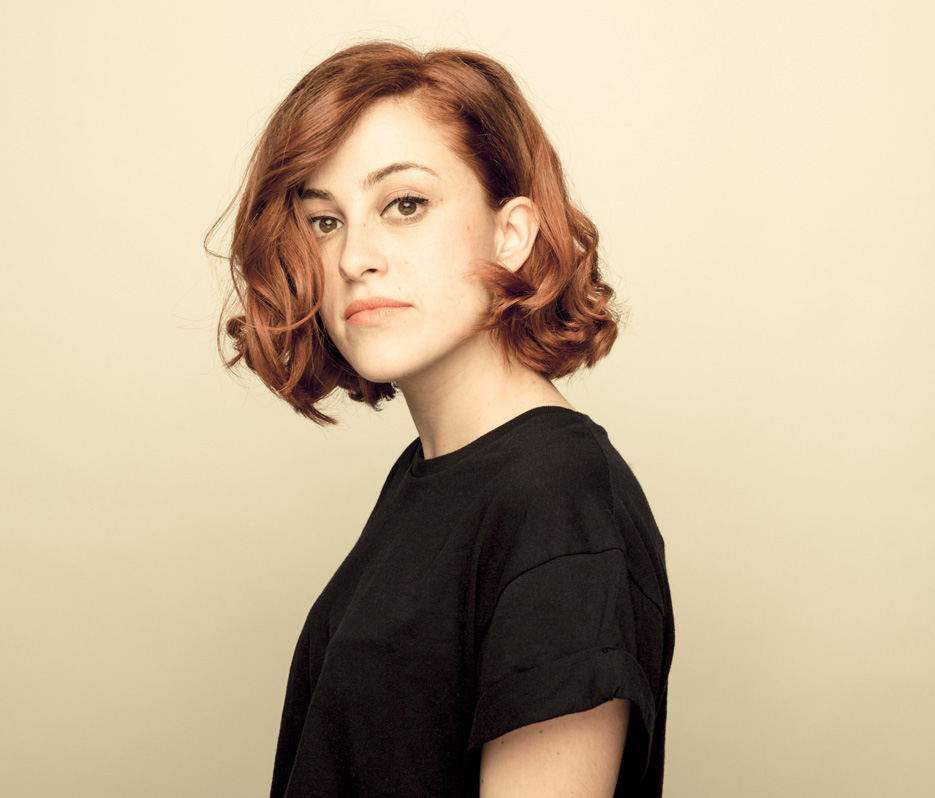 Cristina Martín: I come from a town just outside of Barcelona, where I lived before moving to London. I think what characterizes Barcelona is joy, light and colour. This has markedly influenced my work. I have lived in London for almost one year and time is flying by. As I spend more time in this city the presence of motifs, characters and colours of my home town have appeared more strongly in my work. Maybe this is an expression of longing and searching for my roots.
Cristina Martín: I come from a town just outside of Barcelona, where I lived before moving to London. I think what characterizes Barcelona is joy, light and colour. This has markedly influenced my work. I have lived in London for almost one year and time is flying by. As I spend more time in this city the presence of motifs, characters and colours of my home town have appeared more strongly in my work. Maybe this is an expression of longing and searching for my roots.
EF: How did your relationship with art begin? What is your background in art? What is your background in general?
CM: I never knew how to play with dolls, so when I was very young I started to draw and tell my own stories. I have been collecting my sketchbooks since I was 5.
My mother says I started to draw (or rather doodle) at age 3. As a child I had a strong obsession with my pens and pencils; everything had to be in perfect order. At 5 years old my parents sent me to an art class in my town. I remember fondly carrying my sketchbook and my case and going by bike to school. I went there until I started university every single evening! The first years of university were a little disappointing. I felt very lost in my work and unmotivated. Fortunately this feeling disappeared by the end of the course. Everything was better. I completed my degree in Fine Arts at the University of Barcelona in 2010. By then I had 3 or 4 years experience teaching – at the extracurricular school where I spent my childhood. There I learned about the children’s work and how magical the smaller stories are. That’s how I combined my two passions: art and education.
EF: What led you towards art as a career? Did you always want to be an artist?
CM: It may sound romantic but yes, I did. I never imagined doing something unrelated to what makes me happy. I want to make a living from my art, though we are all familiar with the romantic idea of the artist and the sacrifice that entails.
EF: What would you call your prominent medium and how would you explain it?
CM: The material that gives me the most satisfaction is wood. I like to find wood that has already been used, offcuts or wood that is imperfect in some way. I do not like working on a pristine surface. I paint the wood with acrylic. Another medium which I cannot do without is ink on paper. I spend hours drawing and colouring. It is a method that allows me to be accurate in the detail.
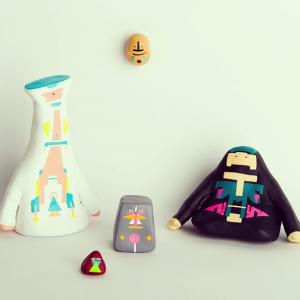
EF: What other mediums do you dabble in (I saw a stop-motion/claymation film on your website, is that something we may be seeing more of – or will you be sticking with 2D works?)
EF: How would you describe your career in a couple sentences?
CM: I think it is work that speaks of, or even betrays, personal experiences and concerns of the subconscious, through landscapes and characters that match their own symbolism to an individual vocabulary.
EF: How would you describe your artwork in 4 words or less?
CM: Mysterious, magical, tribal, alive!
EF: What led you towards the incorporation of hard, geometric shapes and bright colors in your artwork?
CM: Initially I sought to represent a more global, generic feeling, which I happened to achieve through geometry and the combination of colours. Then, step by step, I incorporated my imagination. I am currently using more organic shapes for more figurative representation. Since I moved abroad, I have had to adapt to other customs and lifestyles. Even the light is completely different. For that reason, I felt like I needed to make my roots re-emerge, by evoking the vivid colours of Barcelona.
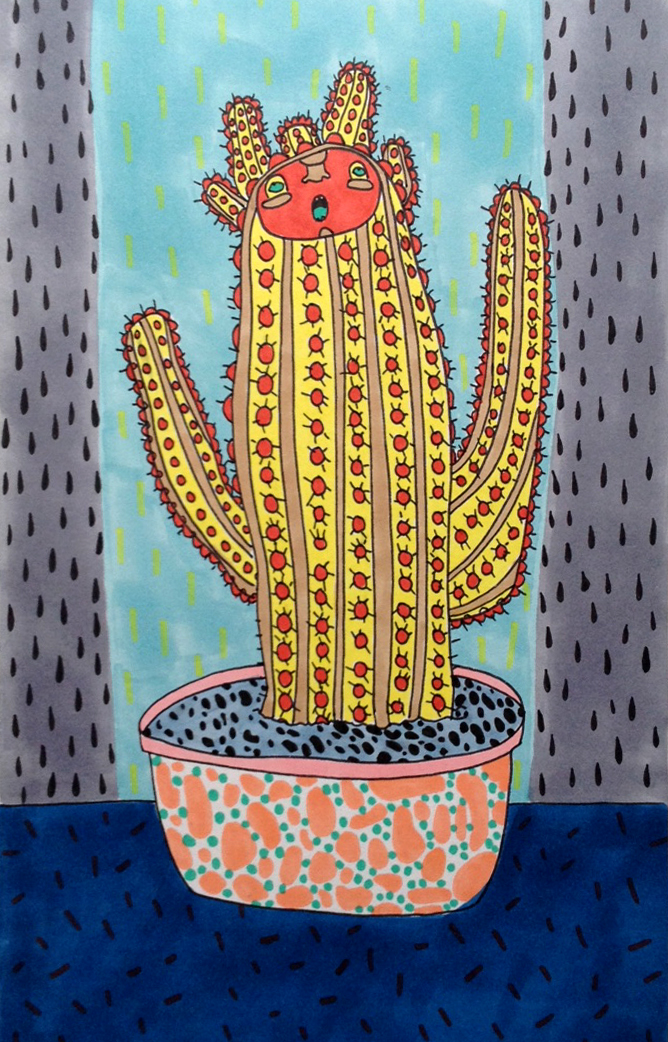 EF: Your artwork has a nice tribal feel to it. Where does this come from? Why does this appeal to you?
EF: Your artwork has a nice tribal feel to it. Where does this come from? Why does this appeal to you?
CM: I am interested in tribal art because it is usually characterized by representations of the spiritual and the natural. I like the compositions and the simplicity of the forms that represent humans and animals. I am interested in the aesthetics of art created by people who do not have a professional background. I love the idea that a piece of art can become a very important means for a human group to identify themselves and how that identity becomes preserved in time.
EF: What inspires your creations? Where do you get your ideas?
CM: From my immediate experiences, memories, dreams, music, folklore…
EF: Walk us through your creative process – from inception to execution.
CM: I start working whenever my ideas start flowing altogether. Then I try to seize them and organize them on paper. I generally do not make sketches when I work on paper; I prefer to draw directly, I like to give free rein to my imagination, without planning what I am going to do. I like a certain imperfection in drawings. I always need a coffee before starting and I listen to music while I work.
EF: What items/tools are essential for making your creations? What are they?
CM: A humble ball-point pen is essential for drawing and illustration – with acrylics, brushes and wood as a base when it comes to painting.
EF: What do you enjoy most about doing this type of artwork?
CM: No matter the artistic endeavour, what I absolutely love is getting it done! And what I least like is cleaning the brushes.
EF: What have you learned about yourself by doing this form of art?
CM: I have learned to listen to and understand myself and be able to express what is in my mind. I have also realized that I am stubborn and impatient.
EF: Do you work on one project at a time until finished – OR – do you work on multiple projects simultaneously?
CM: I normally finish what I start; although I tend to work on two pieces at a time, so that when I get tired of one, I can dedicate myself to the other one, until I finish both.
EF: How long does it usually take to finish a piece? Does it vary widely?
CM: It depends on how willing or inspired I am to work. I can vary from one day to another. It also depends on the amount of work and the technique required. I tend to create one drawing a day in my notebook. If I work on a larger drawing, I might finish it within four days. It normally takes me about one week to finish a painting, depending on the size and the level of detail involved.
EF: How do people react to your artwork? How would you like them to react? What would you like your audience to take away from your work?
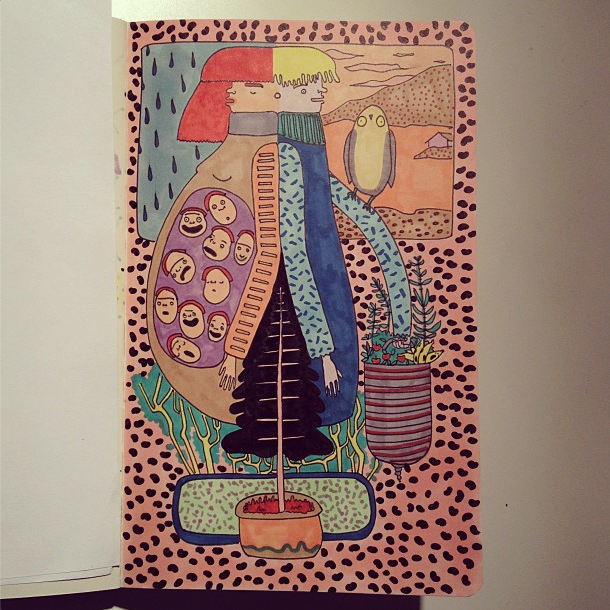
CM: I like to think that my work is interpreted by people using their own imagination and personal story/experience, in the way they interpret my stories, characters and landscapes. I feel rewarded when I receive such feedback, and people tell me what they see in my work. Even when I just see them smiling or grinning or simply saying “WOW!” I can’t always understand what they mean, but I like it!
I would like to create a moment in which the viewer becomes lost in their own thoughts and inner world. I like to provoke, by freely saying whatever I think.
EF: Can you describe your history with children and art?
CM: This experience was such an amazing opportunity to discover art in its pure state, full of illusions, incongruences, strength and vitality. I started to work as a teacher when I was just 17. Then I proceeded as a tutor of child art till I turned 25 and I moved to London. Every day I was surrounded by colours and music in the company of all those fabulous little creatures!
EF: What have you learned about yourself from working with kids? About art?
CM: I learned to be confident to express my ideas and vision, no matter how irrational they can sound. Everything is fair for a child; nothing is prohibited! They are free in their themes, their instinct to use color, composition…everything!
EF: What is the most challenging aspect of working with children? What is the most rewarding?
CM: The most challenging aspect was also my main goal: to motivate the students to come to school with a positive outlook. The hardest part was to make sure that they did their homework and returned willing to show what they had drawn.
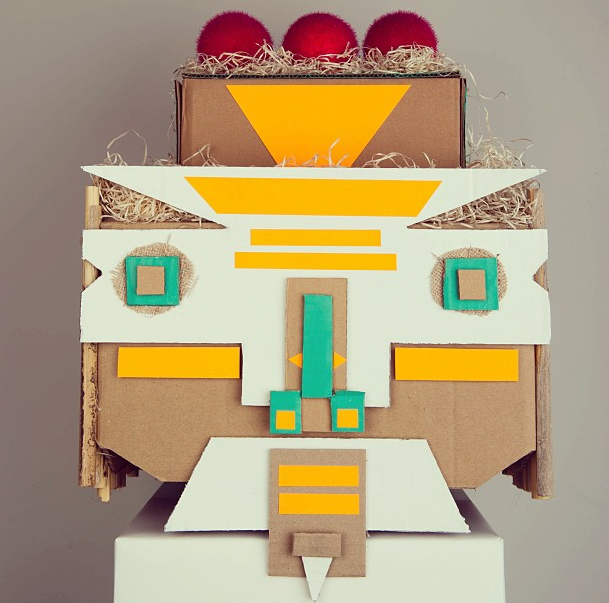
It is hard to confront the persistent stereotypes that form within schools, which say that a drawing is good when it “looks nice”. I worked very hard to convey a different perspective of art, meant rather as an instrument to learn to discover oneself, beyond any aesthetic labels imposed by society.
EF: So far, what has been your favorite lesson plan?
CM: What I most liked was to revise my students’ “diaries”. It was like a notebook that they used as their “artist’s book” where they did their homework. I really discovered some amazing things from them!
One of the jobs I enjoyed most was when we elaborated masks with cardboard boxes and acrylic. Each student created their own mask (and I created mine). Each of these masks correspond to a member of the tribe the class designed. The results were surprising!
EF: Are you still an art educator or are you now a full time artist?
CM: When I moved to London I wanted to concentrate my efforts on my personal work but I am very keen to become involved in arts education again.
EF: Tell us about your most current (or recent) projects? You mentioned something about your new paintings? (I have seen some great new pieces on instagram!)
CM: Right now I am dedicated to creating a new volume of works and renewing my website. I’m also working on a zine which I will distribute in London and I have in mind some silkscreen prints.
EF: Where do you get/find inspiration for new pieces?
CM: I find inspiration when I travel, meeting interesting people and exploring different customs and traditions. I also find inspiration in traditional music from different ages and countries. Recently I am listening to Brazilian, Latino American music, and independent Japanese artists. I love 80’s music and listening to the radio.
EF: Do you ever have the artist equivalent of “writers block?” How do you surpass this so you can keep/finish creating?
CM: Occasionally you get stuck. Sometimes this block lasts only a few hours but occasionally it might take two months before passing. When this happens I try to work in a totally different manner or I go for a walk or have a drink. If the blockage persists for a longer period I take the opportunity to visit exhibitions and discover new galleries or book stores.
EF: If you had to pick one piece of your work to represent yourself as an artist, which would it be and why?
CM: I would choose “La Folclórica” or “The Hope” because they represent the space between the subconscious and my imagination, the weight of symbols in my work and the overlapping of stories. This is right where I am artistically.
EF: For whom do you create? Who is your audience?
CM: I create compulsively… I think my work can appeal to many people, of different ages and backgrounds. People can read it in different ways.
EF: How do you promote your work? Do you seek out opportunities or do they come to you?
CM: Recently I’ve had a hiatus because I have been totally focused on production. I am gradually announcing my presence in this new city and welcoming new contacts!
EF: How do you continue to challenge yourself and grow as an artist?
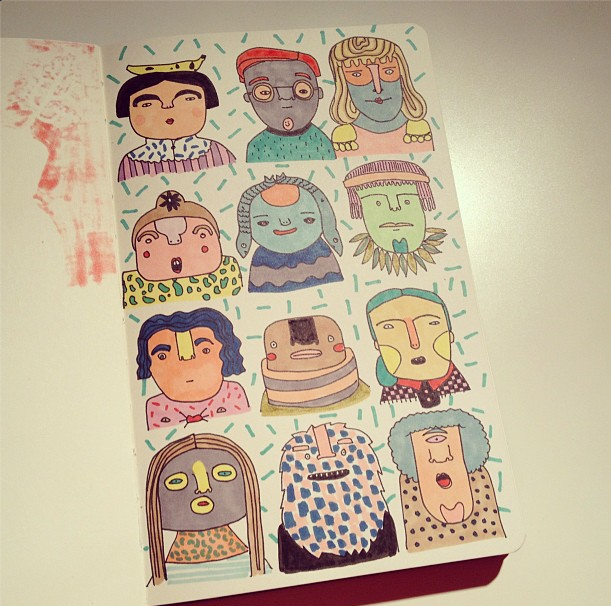 CM: I believe that the best way to survive in the art world is to keep learning from oneself, re-creating oneself and working hard every day. If you feel your work is good, it is good to create a network to circulate your ideas.
CM: I believe that the best way to survive in the art world is to keep learning from oneself, re-creating oneself and working hard every day. If you feel your work is good, it is good to create a network to circulate your ideas.
EF: Do you sell your artwork? If-so, what is the price-range and where can we buy it?
CM: Yes, I do sell my work. For more information or commissions please find my e-mail contact here: contact@cristinamartin.me
EF: To date, which project has given you most satisfaction?
CM: I most enjoy developing educational material on the subject of art, to be used by young little students! Moreover, I enjoy the ongoing satisfaction that comes from seeing progress in my work.
EF: What artists do you admire and why?
CM: I have a great admiration for artists such as Henri Rousseau, for the exoticism and predominant naive style of his paintings. I love the personal themes in Frida Kahlo’s art. I am greatly influenced by what they call the “first avant-garde”, the German expressionist artists like Ernst Ludwig Kirchner or Matisse as part of the French Fauvism. I’m a fan of Herve Telemaque, Patrick Caulfield and young artists and illustrators such as Richard Colmann, Megan Whitmarsh, my friend Zosen, Michael Swaney, Mike Perry, Yeji Yun, Katia Fouquet, …
EF: Do you have a favorite piece of art (other than your own)?
CM: I have favourite artists but not a favourite piece of art.
EF: What is the best piece of advice you have ever received?
CM: “Be yourself.” That sounds simple, but it takes time and effort to work this out.
EF: What is your favorite book?
CM: A good dictionary of symbols!
EF: Do you have a favorite quote?
CM: I don’t know about a quote but I like to learn sayings and idioms. ”Don’t ruffle my feathers!”
EF: Where can we see more?
Website: http://cristinamartin.me/
Business Boom Collective: http://businessboomcollective.com/0419/cristina-martin/
Recent Works: http://instagram.com/cristinamartinillustration
